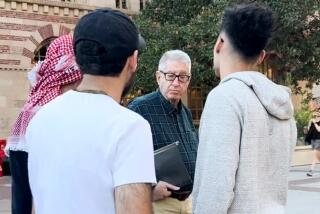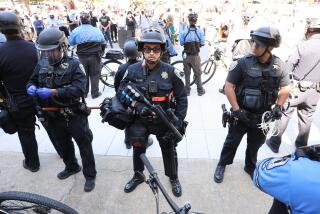Fatally Stabbed Professor’s Care Assailed
- Share via
A UC San Diego professor who died 10 days ago from stab wounds should have been transferred to a trauma hospital instead of being treated at a small East San Diego hospital, a leading San Diego trauma surgeon said Tuesday.
“There’s no question he should have been transferred here,” said Mercy Hospital trauma surgeon Dr. Richard W. Virgilio. “Sure, I’m upset. It could have been you. It could have been me.”
Charles W. Thomas, a UCSD psychology professor lauded as the father of black psychology, died during surgery at 1:40 a.m. Sept. 30. That was nearly 2 1/2 hours after a passer-by took him to Villa View Community Hospital at 5550 University Ave.
The circumstances of how Thomas received the wounds are unknown and police investigating the case have made no arrests. The passer-by had found him in his car in a bank parking lot, stabbed several times in the abdomen.
Under county trauma system guidelines, these injuries made him a prime candidate for transfer to a trauma center.
“Even if they’re dead already, and they have penetrating wounds, they’ll go to a trauma hospital--because that’s the only place you’d have a chance,” Virgilio said. “And this guy was far from dead. He had 2, 2 1/2 hours before he died.”
Asked to reply to Virgilio’s concerns, Villa View administrator Jonathan Sprecher said the comments were made without enough information about Thomas’ case. Sprecher said his hospital acted quickly and appropriately, but Thomas had lost too much blood before he arrived at the hospital.
“This patient arrived in our facility at 11:10 p.m. He was in full-blown (heart) arrest at 11:20. . . . When we had a heartbeat back on him, I had surgeons ready and available, and they immediately took him into surgery. That is in no way inappropriate medical care,” Sprecher said.
“Had we been able to transfer him, had he been stable at all to be transferred, we would have gladly transferred him,” he added.
In past cases, Villa View has routinely transferred such patients to Mercy after they arrived at Villa View’s emergency room by private car, both men said.
Virgilio said he was out of town when Thomas died, but checked with Villa View afterward to ask why the transfer had not occurred. The reply was that the emergency room physician on duty at the time was filling in for the regular physician, and was not familiar with the country trauma system, Virgilio said.
Sprecher agreed that the emergency physician on duty was new to Villa View, but he said it was Thomas’ low to “nonexistent” blood pressure that prevented the transfer.
Without a detailed review of a traumatic death, no outside doctor can say definitively whether the life would have been saved if the patient had been at a trauma hospital, trauma doctors agree. However, numerous studies and statistical reports show a drop in preventable deaths when such patients are funneled into trauma centers.
Consisting of six hospitals stretching from Escondido to San Diego, the San Diego County trauma system was set up in 1984. Teams of surgeons and nurses are on duty around-the-clock to meet the special needs of trauma patients.
In addition, services such as a fully equipped blood bank have to be available 24 hours at trauma centers. This is because penetrating wounds or blunt injury can cause catastrophic internal bleeding.
Often this is because of a damaged portal vein that conveys blood from the abdominal organs to the liver. It was an injury to this vein that caused Thomas’ massive blood loss before he reached the hospital, Sprecher said.
Sprecher would not say, however, what time Thomas went into surgery or how much blood he was given before and during surgery, citing privacy considerations.
When Thomas arrived at Villa View at 11:10 p.m. Sept. 29, he was still conscious and talking, police say. Sprecher said Thomas lost consciousness within a few minutes.
Gail Cooper, chief of emergency services for San Diego County, said at Tuesday that her office was concerned about Thomas’ death.
“EMS is looking into it,” Cooper said. “It appears that the (trauma) system did not work for Dr. Thomas.”
She added that the inquiry was being hampered because Villa View officials had failed to return phone calls.
Contacted about an hour later, Sprecher said Villa View’s chief of staff, Dr. James Norton, had called Cooper’s office in the intervening hour to talk about the case.
He denied that there had been any “official communications” from the county. “Calling and talking to a staff nurse does not constitute official communication,” Sprecher said.
Coroner’s autopsy results on Thomas were not available Tuesday.
Traumatic-injury patients who do not make it into the trauma system are a continuing concern among trauma doctors, Virgilio and others say. However, it only happens a few times a year, he said.
More commonly, hospitals or paramedics “overtriage” patients, referring them to trauma centers when their injuries are not severe enough, he said. That situation is considered preferable, however, because it prevents unnecessary deaths from injuries that are catastrophic but sometimes missed in a basic hospital emergency room.
The Thomas case is expected to be discussed next week at a meeting of the trauma system’s medical audit committee, although the panel’s detailed consideration of the case won’t occur for about three months, Cooper said.
More to Read
Sign up for Essential California
The most important California stories and recommendations in your inbox every morning.
You may occasionally receive promotional content from the Los Angeles Times.









